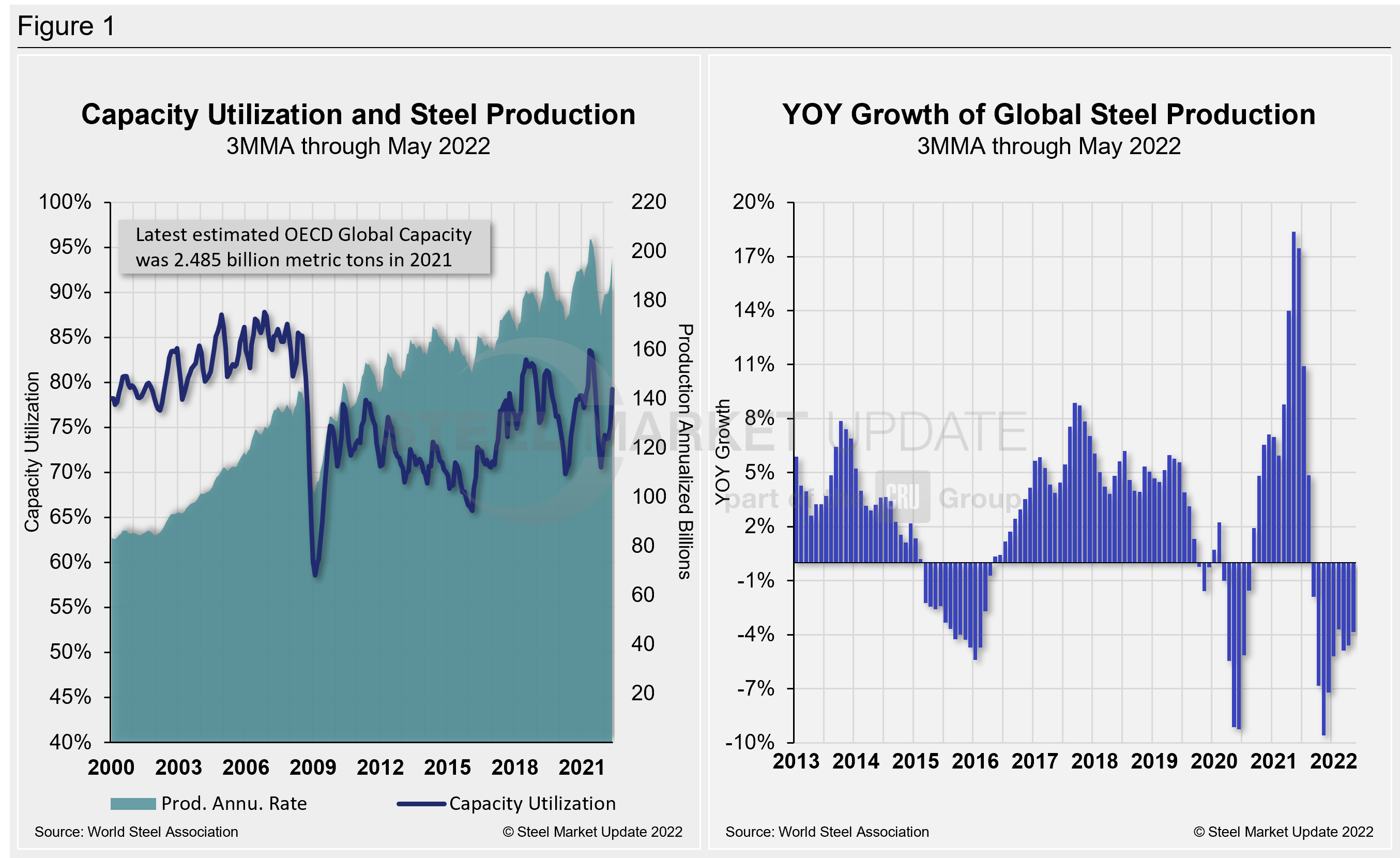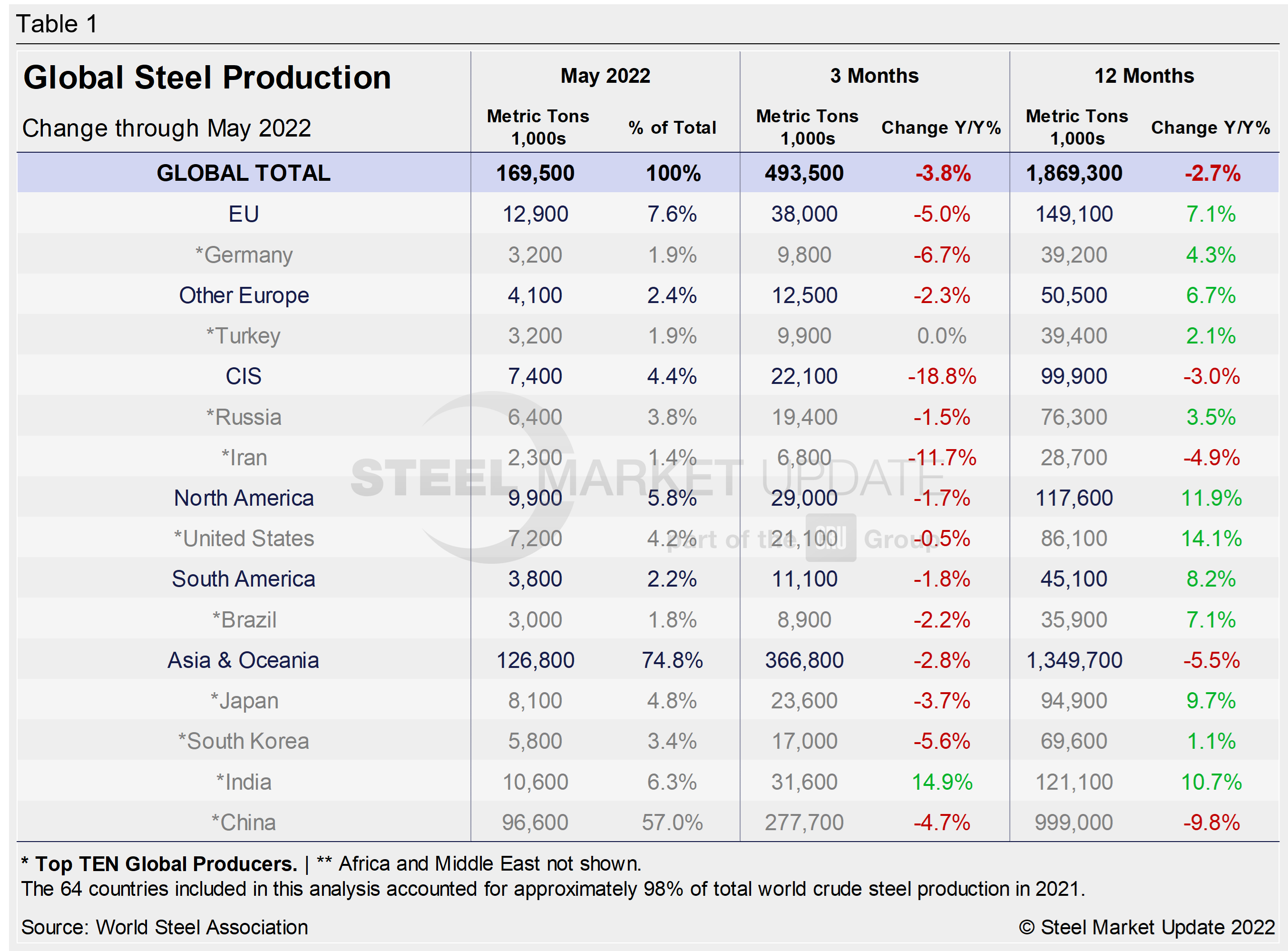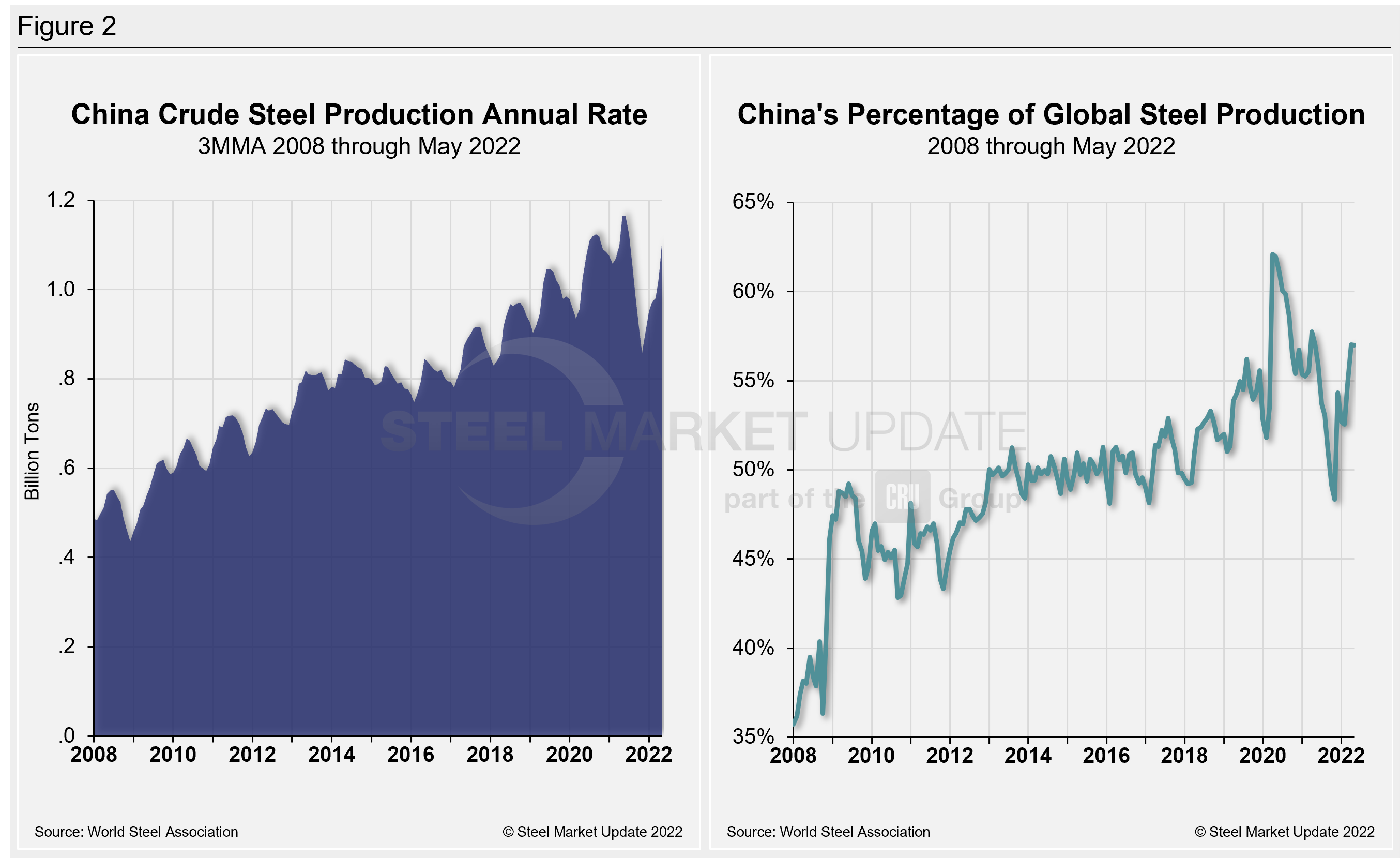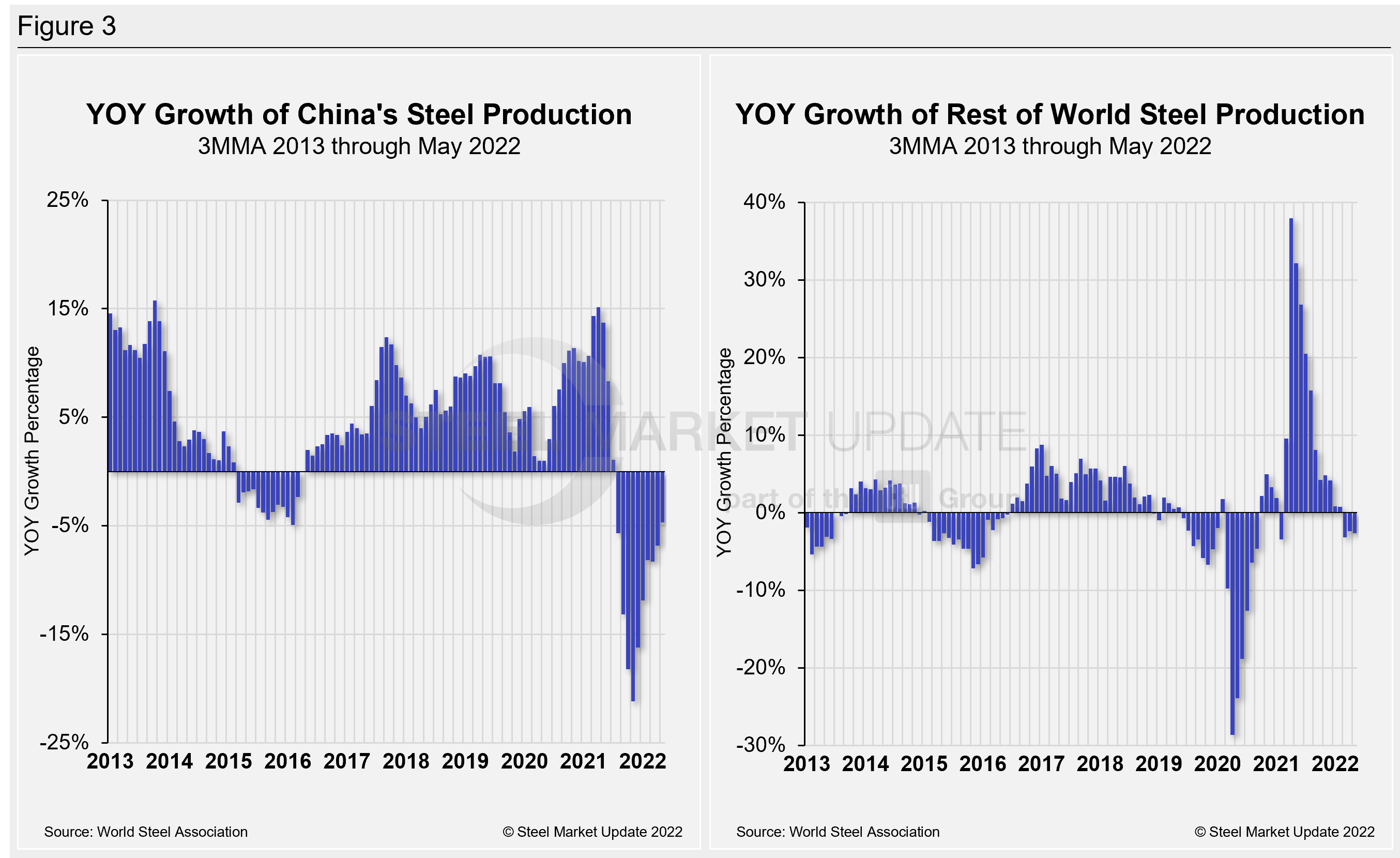Economy

China Drives Global Steel Production Gains in April: WSA
Written by David Schollaert
June 3, 2022
World crude steel production rose in April, gaining ground for a second consecutive month and reaching a 10-month high. Global output was estimated at 162.7 million metric tons in April. Steelmakers around the world increased production by just 1.6 million metric tons, or 1% from March, according to World Steel Association (worldsteel) data.
Although April’s crude steel production expanded, the pace of growth slowed versus the nearly 13% expansion seen the month prior. The gain was driven primarily by a 5.1% production increase month on month (MoM) in China, while eight of the top 10 steel-producing nations saw lower MoM output. Crude steel production in the rest of the world fell MoM in April by 4.0%, to a total of 69.9 million metric tons
Despite the MoM gain, April’s global total was down 4%, or 6.8 million metric tons, from April 2021 and was off by 11.7 million metric tons from the high-water mark set in May 2021. The continued growth in April pushed total output up 3.2%, or 5.1 million metric tons, versus the pre-pandemic period of April 2019.
The US remained the fourth-largest crude steel producer in the world in April, accounting for 6.9 million metric tons, or 4.2%, of the global total. US production last month slipped by 1.4%, or 100,000 metric tons, versus March’s total.
April’s US production equaled the total output from April 2021. Recall that the US economy was then recovering from pandemic shutdowns in 2020. But April 2022 was down 6.2% versus the pre-pandemic period in April 2019.
Shown below in Figure 1 is the annualized monthly global steel production on a three-month moving average (3MMA) basis and capacity utilization since January 2000. Also shown is the YoY growth rate of global production on the same 3MMA basis since January 2013. Both are based on data from worldsteel.

Mill capacity utilization in April on a 3MMA basis was 75%, up 1.2 percentage points from the month prior. On a tons-per-day basis, production in April was 5.423 million metric tons, a 4.4% MoM increase. That figure is 390,000 tons off May 2021’s record rate of 5.813 million metric tons. Growth on a 3MMA basis through April YoY was down 4.6%, a 0.3 percentage point improvement from the month prior. It’s still a far cry from the 18.4% expansion seen in May of last year.
Displayed in the table below is global production broken down into regions. It shows the production of the top 10 nations in April and their share of the global total. It also shows the latest three months and 12 months of production through April with YoY growth rates for each period. Regions are shown in black font and individual nations in gray.
World steel production overall is down in both the three- and 12-month comparisons, a significant deceleration from the 17.9% growth just 10 months prior. Despite recent gains, the market has not maintained positive momentum: the three-month growth rate has been lower than the 12-month growth rate for eight consecutive months now.

The table shows that North American production was down 1.1% in the three months through April and up 15.7% YoY. The positive momentum in the North American market indicates that the economy has been strong despite the pandemic and inflation. Yet, when compared to the same pre-pandemic period in 2019, the present output is down 8.3%.
China’s Crude Steel Production
China’s monthly steel production was estimated at 92.8 million metric tons in April, up from 88.3 million metric tons the month prior. The 4.5-million-ton monthly increase was a steady gain following a sharp 13.3-million-ton gain the month prior. April is just the third month of steel production growth in China since crude steel output reached its all-time high of 99.5 million metric tons last May. But it nonetheless represents a ten-month high.
On a 3MMA basis, the annual rate of China’s crude steel production maxed out at 1.123 billion metric tons in September 2020. It has fallen repeatedly since February of last year. China’s annual capacity stands at 1.128 billion metric tons. Its annual capacity utilization slipped to 88.8% last month, its lowest mark in 20 months and down from an all-time high of 98.4% last June.
China produced more than half of the world’s steel in April, 57%, or an estimated 92.8 million metric tons. Although April’s total was a 5.1% gain over March, it was a 5.2% decline compared with the same year-ago period. Chinese production in April this year was 9.3% above pre-pandemic levels in April 2019.
China’s crude steel production rate and its percentage of global output are displayed side-by-side in Figure 2.

The fluctuations in China’s steel production since January 2013 versus the growth of global steel excluding China, both on a 3MMA basis, are shown side-by-side in Figure 3. From October 2020 through December 2021, the rest of the world’s production rose sharply, reaching a peak of 38.0% in April. Since then, the rate for the rest of the world’s annual production has decreased sequentially to -3.2% in March. April’s percentage improved slightly to -2.4%. China’s annual growth rate was -6.8% in April, an improvement from -8.3% in March. Annual growth is nowhere near the +15.1% seen last April.

By David Schollaert, David@SteelMarketUpdate.com

David Schollaert
Read more from David SchollaertLatest in Economy

ISM: Manufacturing expansion loses steam after two months of growth
US manufacturing activity slowed in March after two straight months of expansion, according to supply executives contributing to the Institute for Supply Management (ISM)’s latest report.

Chicago Business Barometer rose to 16-month high in March
The Chicago Business Barometer increased for the third-consecutive month in March. Despite this, it still reflects contracting business conditions, as it has since December 2023.

Durable goods orders rise again in February
Transportation equipment led the increase, rising 1.5% to $98.3 billion.

Consumer confidence falls for fourth consecutive month
People remain concerned about inflation, trade policies, and tariffs.

Housing starts ticked up in February
Single-family starts last month hit a rate of 1.10 million, a month-over-month increase of 11.4%, census data shows.
